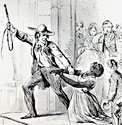
A Sabbath Scene
 One of Whittier’s poems with popular emotional appeal was “A Sabbath Scene” that describes a fugitive slave girl, barefooted and thin, running into a church to be protected from the slave hunter following her, whip in hand. She was caught with the help of the minister, who explained to his congregation the Scriptural justification of slavery. At this point, Whittier claimed in a stanza later removed, he had awakened from this dream that had been the result of some pamphlets he had been reading, justifying the Fugitive Slave Law. Although he removed this stanza, Whittier included an explanatory note:
One of Whittier’s poems with popular emotional appeal was “A Sabbath Scene” that describes a fugitive slave girl, barefooted and thin, running into a church to be protected from the slave hunter following her, whip in hand. She was caught with the help of the minister, who explained to his congregation the Scriptural justification of slavery. At this point, Whittier claimed in a stanza later removed, he had awakened from this dream that had been the result of some pamphlets he had been reading, justifying the Fugitive Slave Law. Although he removed this stanza, Whittier included an explanatory note:
“This poem finds its justification in the readiness with which, even in the North, clergymen urged the prompt execution of the Fugitive Slave Law as a Christian duty, and defended the system of slavery as a Bible institution.”
The slave girl, running from her hunter, is described:
Like a scared fawn before the hounds,
Right up the aisle she glided,
While lose behind her, whip in hand,
A lank-haired hunter strided.
When the hunter says:
“I’ve law and gospel on my side,
And who shall dare refuse me?”
The parson tells the deacon to throw down a holy book and trip the girl up. She is caught and bound hand and foot. And as the parson is helping, he explains:
“Although,” said he, “on Sabbath day
All secular occupations
Are deadly sins, we must fulfil
Our moral obligations: …”
Whittier imagines that he, Whittier, is in the congregation and protests:
“Foul shame and scorn be on ye all
Who turn the good to evil,
And steal the Bible from the Lord,
To give it to the Devil!”
Whittier is accused of being an infidel and committing treason, and he awakens suddenly to the sound of the supper-bell.
p>Full text of "A Sabbath Scene"
